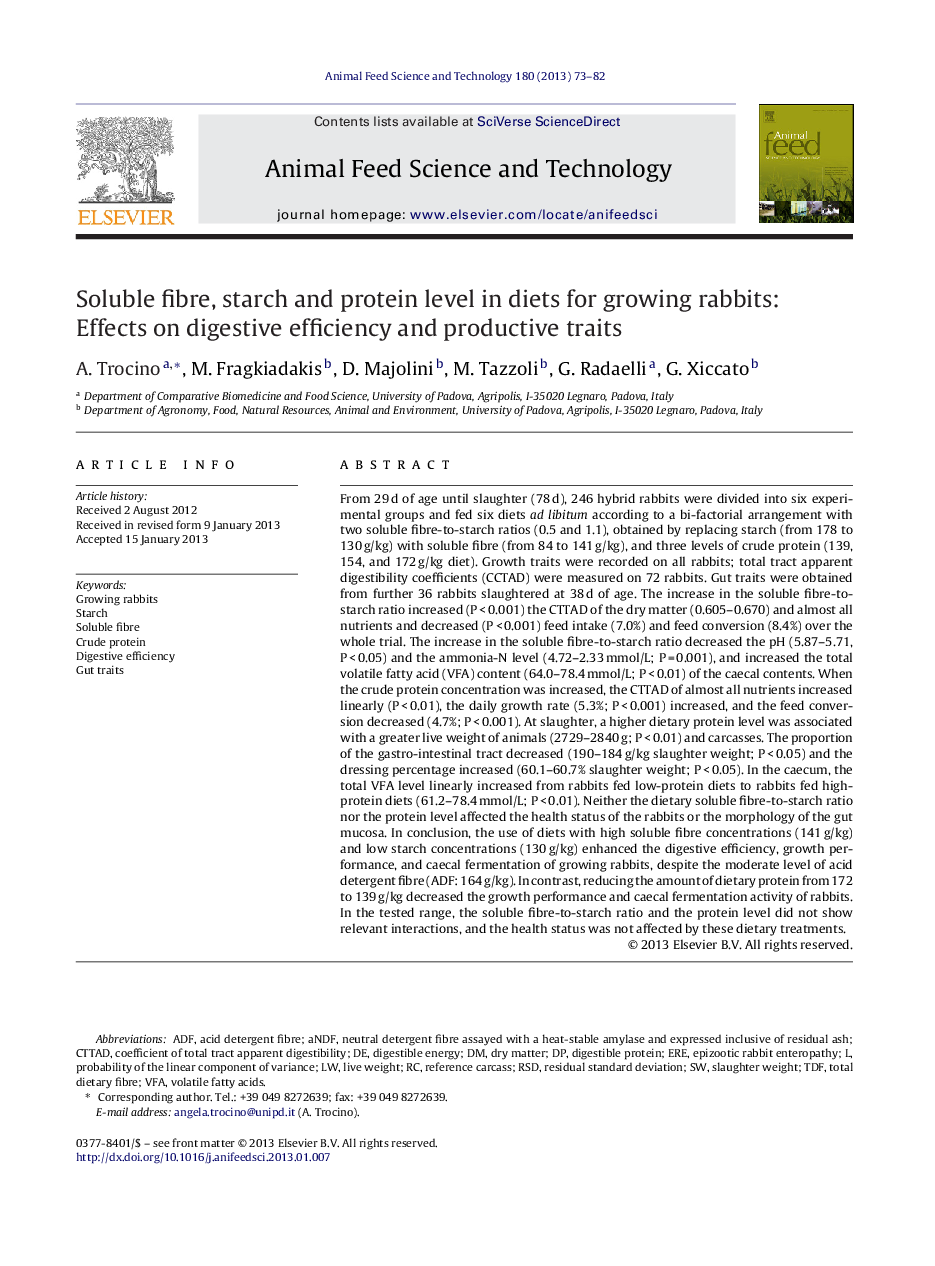| کد مقاله | کد نشریه | سال انتشار | مقاله انگلیسی | نسخه تمام متن |
|---|---|---|---|---|
| 8491990 | 1552408 | 2013 | 10 صفحه PDF | دانلود رایگان |
عنوان انگلیسی مقاله ISI
Soluble fibre, starch and protein level in diets for growing rabbits: Effects on digestive efficiency and productive traits
ترجمه فارسی عنوان
فیبر محلول، میزان نشاسته و پروتئین در رژیم های غذایی برای رشد خرگوش ها: تاثیر بر راندمان گوارشی و صفات تولیدی
دانلود مقاله + سفارش ترجمه
دانلود مقاله ISI انگلیسی
رایگان برای ایرانیان
کلمات کلیدی
ADFCTTADERETDFRSDaNDFVFAVolatile fatty acids - اسیدهای چرب فرارacid detergent fibre - الیاف پاک کننده اسیدEpizootic Rabbit Enteropathy - انتروپاتی خرگوش اپیزوResidual standard deviation - انحراف استاندارد باقی ماندهDigestible energy - انرژی قابل هضمGrowing rabbits - در حال رشد خرگوشDigestive efficiency - راندمان گوارشیcoefficient of total tract apparent digestibility - ضریب هضم ظاهری کل دستگاهtotal dietary fibre - فیبر رژیمی کلSoluble fibre - فیبر محلولdry matter - ماده خشکStarch - نشاسته Live weight - وزن زندهSlaughter weight - وزن کشتcrude protein - پروتئین خامdigestible protein - پروتئین قابل هضم
موضوعات مرتبط
علوم زیستی و بیوفناوری
علوم کشاورزی و بیولوژیک
علوم دامی و جانورشناسی
چکیده انگلیسی
From 29Â d of age until slaughter (78Â d), 246 hybrid rabbits were divided into six experimental groups and fed six diets ad libitum according to a bi-factorial arrangement with two soluble fibre-to-starch ratios (0.5 and 1.1), obtained by replacing starch (from 178 to 130Â g/kg) with soluble fibre (from 84 to 141Â g/kg), and three levels of crude protein (139, 154, and 172Â g/kg diet). Growth traits were recorded on all rabbits; total tract apparent digestibility coefficients (CCTAD) were measured on 72 rabbits. Gut traits were obtained from further 36 rabbits slaughtered at 38Â d of age. The increase in the soluble fibre-to-starch ratio increased (PÂ <Â 0.001) the CTTAD of the dry matter (0.605-0.670) and almost all nutrients and decreased (PÂ <Â 0.001) feed intake (7.0%) and feed conversion (8.4%) over the whole trial. The increase in the soluble fibre-to-starch ratio decreased the pH (5.87-5.71, PÂ <Â 0.05) and the ammonia-N level (4.72-2.33Â mmol/L; PÂ =Â 0.001), and increased the total volatile fatty acid (VFA) content (64.0-78.4Â mmol/L; PÂ <Â 0.01) of the caecal contents. When the crude protein concentration was increased, the CTTAD of almost all nutrients increased linearly (PÂ <Â 0.01), the daily growth rate (5.3%; PÂ <Â 0.001) increased, and the feed conversion decreased (4.7%; PÂ <Â 0.001). At slaughter, a higher dietary protein level was associated with a greater live weight of animals (2729-2840Â g; PÂ <Â 0.01) and carcasses. The proportion of the gastro-intestinal tract decreased (190-184Â g/kg slaughter weight; PÂ <Â 0.05) and the dressing percentage increased (60.1-60.7% slaughter weight; PÂ <Â 0.05). In the caecum, the total VFA level linearly increased from rabbits fed low-protein diets to rabbits fed high-protein diets (61.2-78.4Â mmol/L; PÂ <Â 0.01). Neither the dietary soluble fibre-to-starch ratio nor the protein level affected the health status of the rabbits or the morphology of the gut mucosa. In conclusion, the use of diets with high soluble fibre concentrations (141Â g/kg) and low starch concentrations (130Â g/kg) enhanced the digestive efficiency, growth performance, and caecal fermentation of growing rabbits, despite the moderate level of acid detergent fibre (ADF: 164Â g/kg). In contrast, reducing the amount of dietary protein from 172 to 139Â g/kg decreased the growth performance and caecal fermentation activity of rabbits. In the tested range, the soluble fibre-to-starch ratio and the protein level did not show relevant interactions, and the health status was not affected by these dietary treatments.
ناشر
Database: Elsevier - ScienceDirect (ساینس دایرکت)
Journal: Animal Feed Science and Technology - Volume 180, Issues 1â4, 15 March 2013, Pages 73-82
Journal: Animal Feed Science and Technology - Volume 180, Issues 1â4, 15 March 2013, Pages 73-82
نویسندگان
A. Trocino, M. Fragkiadakis, D. Majolini, M. Tazzoli, G. Radaelli, G. Xiccato,
